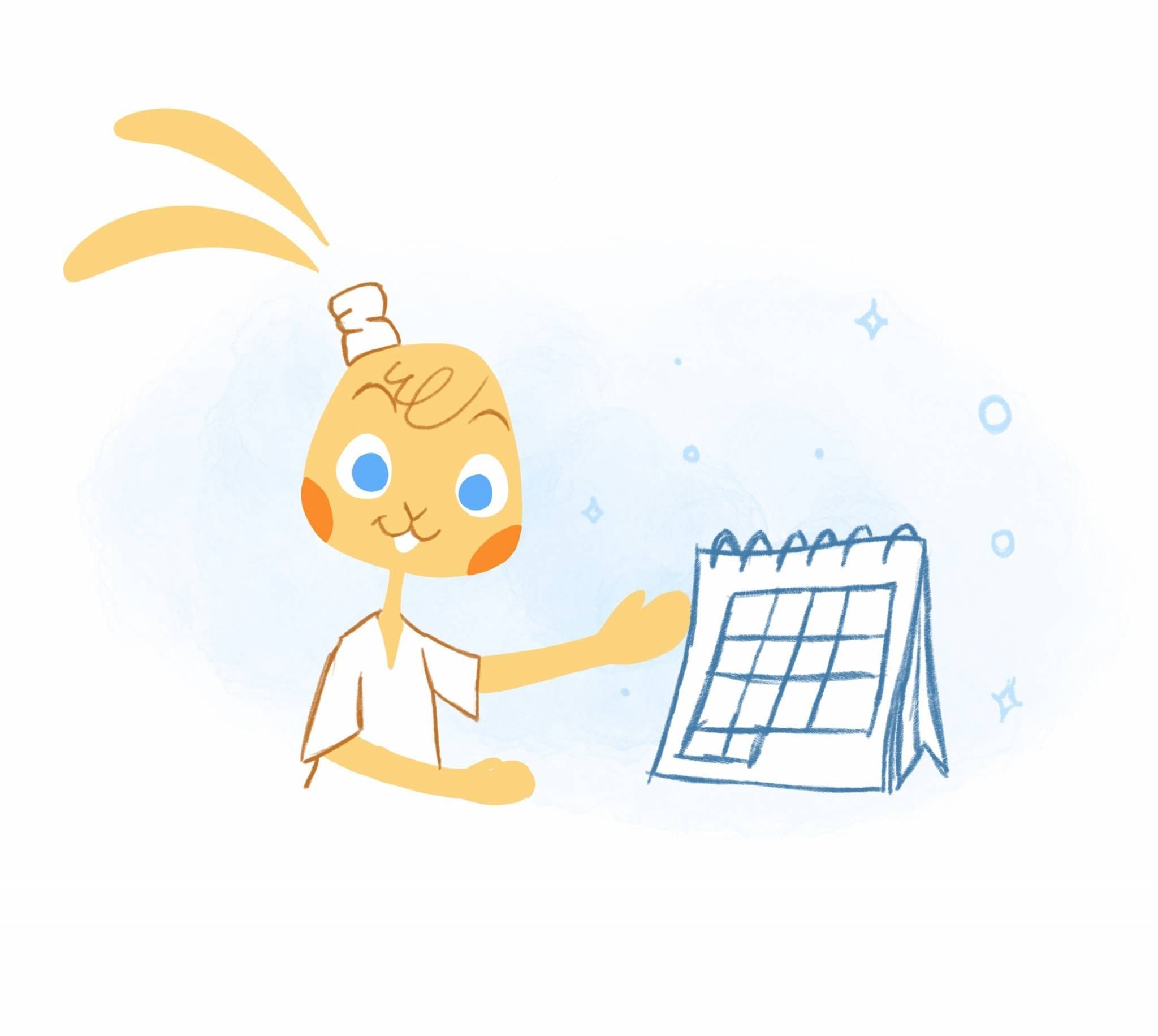

It might sound hyperbolic. But, there’s no better way to manage your time than with a calendar. After all, having a schedule and following it may help you be more productive.
What can a calendar do to help you improve your time management skills? In this article, we’ll show you how a calendar can help you manage your time efficiently, along with finding a balance between your responsibilities.
What is Time Management?
As the name suggests, time management is all about managing your time.
But, that doesn’t mean that it’s an easy feat. After all, we all have the same 24 hours in a day. According to experts, six to nine of those hours should be spent sleeping. Preparation and eating of meals take a few hours. You also have to take into account your commute and other minor difficulties. And, that’s not even mentioning your full workday.
The result is that you don’t have much time for socializing, spending time with your family, or taking care of yourself.
With so little time to do so much, how does one cope? That is exactly what time management is all about: staying on top of your priorities while maintaining your sanity.
Why Does Time Management Matter?
It is impossible to skip time management, whether you want to or not. After all, as a member of society, we all have specific responsibilities and obligations. In order to survive, one must fulfill these responsibilities.
Earning money requires work, for instance. It is necessary to have money in order to eat. In the absence of food, you will die of starvation.
At the same time, you must also keep your mind fresh by finding a source of entertainment. Isolating yourself completely will negatively impact your mental health, as well as your ability to earn money.
It’s cyclical — to say the least.
It is for this reason that time management is so crucial. To be successful, you must learn to deal with time constraints.
A lack of time management will only lead to stress. As a result, everything will go downhill mentally, emotionally, and physically. As a result, you should know how to manage your time efficiently.
And, the first place to start is with your trusty calendar.
How to Use a Calendar to Improve Your Time Management Skills
1. Choose the right calendar.
“There’s no shortage of tools that can help you create, edit, and manage your calendar,” states Calendar co-founder and CEO John Rampton. “Whether if it’s booking meetings, receiving event reminders, or keeping your to-do-lists manageable, you’ll need these tools to keep your life in order.”
The question is, how do you select the best calendar tool out of so many options? Consider the following factors as a starting point.
- Ease of use. “The first factor that you need to consider when searching for a calendar tool is ease-of-use,” adds John. Ideally, this means that you “should be able to quickly create your calendar, add events, and share it with others without getting confused or asking for help.”
- Flexibility. To meet your specific needs, your calendar tool should also be flexible. For example, it should come with time zone detection and the ability to set buffers between entries.
- Scaleable. You’ll want a tool that grows with your business. Make sure the tool doesn’t limit how many people you can add or how many locations you can add.
- Integration. Syncing with popular calendar tools such as Google, Outlook, Office 365 or iCloud is essential.
- Customizable. Certain features should be customizable.
- Cloud-based. Your calendar, schedule, or to-do lists should be able to be accessed from any smartphone or tablet.
2. Determine your goals so that distractions can be avoided.
Distractions or noise vary from person to person, and it’s difficult to define what qualifies as a distraction. Rather, determine the difference between your goals and distractions.
Maybe you want to start your own business, finish a project quickly, or find a new job. Anything that takes your attention away from that core goal is considered a distraction. Work time is spent in different ways depending on your goals, so distractions become evident when you evaluate how you spend it. Your emails, for instance, will begin to look like someone else’s task list.
Another example is networking. Don’t spend hours trawling through networking events looking for valuable contacts. Instead, use LinkedIn or Twitter to find people you’d like to connect with. In an ideal world, these would be people who have worked on similar issues and can help you achieve your goals.
As an example, suggest a 20-minute phone call so you don’t have to worry about setting up an in-person meeting or video chat. As a result, you will be able to have more valuable conversations and save time.
After identifying your goals, you can add them to your calendar. Not only will this help you stay laser-focused on them, but this also allows you to track your progress.
3. Prioritize your tasks.
Your priorities might not receive as much attention as you think, even with defined goals. Thankfully, you can take a self-audit to find out.
Keeping a log of the things you do at work and the time you spend on each is a good idea for at least a week. Software can also be used to automate tracking. To accomplish your goals, you must identify the specific distractions that keep you from achieving them.
Then you can prioritize your activities to avoid devoting too much time to a task of low priority or neglecting a high priority. By prioritizing your tasks, you may be able to complete them correctly and efficiently. Take into account how challenging the task is as well as how quickly you would like to accomplish it.
You can also visualize the importance of your responsibilities by assigning different colors to high, moderate, and low-priority rankings. Your responsibilities can be prioritized according to your schedule by reviewing your calendar.
4. Eat that frog.
“Mark Twain once said that if the first thing you do each morning is to eat a live frog, you can go through the day with the satisfaction of knowing that that is probably the worse things that is going to happen to you all day long,” writes Brian Tracy.
How would you define your “frog?” It’s “your biggest, most important task, the one you are most likely to procrastinate on if you don’t do something about it.”
In order to “eat that frog,” Tracy offers these suggestions:
- Whenever you have two crucial tasks to complete, you should start with the one that is the biggest, hardest, and most important.
- You are more likely to be focused and energetic in the morning, so complete your major tasks then.
- Immediately act and discipline yourself “to work steadily and single-mindedly until those tasks are complete.”
- Take on even more important tasks and complete them. It releases endorphins, which lead to the development of a “positive addiction.”
- Until you have perfected this technique, keep practicing.
5. Schedule your time.
Check out your calendar. How does it look to you? Do you have your entries arranged in order, or are they scattered throughout the week or month?
It is one thing to record events and tasks. It is also important to allocate time to them. In order to manage your schedule and allocate resources, like time and money, you should estimate how long it will take to complete the task.
The good news? Several methods are available:
- Time blocking. This method simply involves dividing your day into different activities and assigning blocks of time for each. Whether you use colors, lines, or anything else you like, you can do it any way you like.
- Pomodoro technique. Developed by Francesco Cirillo, it is loved for its effectiveness and the fact that it boosts productivity immediately. Choose a task to accomplish, set a timer for 25 minutes, take a short break, and after four Pomodoro sessions are complete, you can take a longer break and go for a walk, read a chapter of a book, or even just lie down for a while.
- Pareto principle. This is also known as the 80/20 rule, which states that 80% of the results come from 20% of the causes. Therefore, 20% of your work input will result in 80% of your results. Eating the frog will be helpful in this case. To achieve desired results, you need to focus on the most important tasks and work on them until completion.
The benefits of these techniques include staying focused, not having to toggle between multiple activities, and avoiding distractions.
6. Make preplanning a habit.
Time management begins with planning your schedule, which is a fundamental yet often overlooked tactic. Whether you map out the week ahead on a Sunday evening or plan the next day’s events at the end of the day, it’s a guaranteed method to manage a busy schedule.
It is only by managing how you allocate time that you can take control of it. It is possible, for example, to schedule time for emailing so that you can keep your inbox in check. Additionally, having meetings or phone calls scheduled in advance gives a sense of where things stand on key tasks for the next day or week as well as how much free time is left for extra responsibilities.
7. Set up deadlines.
Establish a realistic deadline for your tasks and adhere to it. It may be helpful to write the deadline on a sticky note and keep it near your workspace once you’ve set it. Or, you could set up calendar reminders. Either way, you will be able to stay focused on your task with a visual cue.
It would be helpful to plan your deadline so that you can complete all tasks that may interfere with the task before it is due. Don’t be afraid to push yourself in order to meet the deadline. And, don’t forget to reward yourself for your efforts.
8. Clear some space.
There shouldn’t be too many entries on your calendar. Leaving some space is important.
Why? In the first place, this “free” time might be needed for an urgent task, or a phone call with a client. Second, you’ll be able to express yourself more creatively.
Time management expert Laura Vanderkam writes on her blog that white space can have a positive side, “The limited space on a paper calendar also provides a visual trigger that a day is getting too full. When I’m scribbling calls and appointments in the margins, that’s a sign I need to start scheduling things farther out. Alternately, if I see nothing on a day — an absolutely pristine open day of white space — I’m generally inclined to try to keep it that way. I love completely open days. Maybe something amazing will come along, or else I’ll get to do whatever I feel like!”
I’d also recommend that you occasionally declutter your calendar. If your calendar is too packed, it makes it “impossible to focus on your priorities. And even worse, this leads to unnecessary stress,” explains Calendar co-founder John Hall.
Some strategies to help you declutter your calendar would be questioning all recurring events, deleting old tasks, and verifying scheduling events.
9. Stick to one calendar.
Here’s a simple tip that will save you both time and energy. If you have a work and personal calendar, you may be tempted to keep them separate. Here’s the problem though. As you will constantly have to switch between both calendars, it may cause a lot of confusion and calendar conflicts.
Additionally, writing to-do lists on a calendar may not be the best idea. Having their own notebook or using a dedicated app is a better option. This is especially true if your workflow is full of small tasks that are not worth writing down in your planner.
10. Analyze your schedule.
In case you find that you do not have much free time, you might consider analyzing your schedule. Reconsider each step and determine if every task is necessary and if the time allotted to each is appropriate.
By assigning tasks to others or automating your work with technology, you might be able to approach certain responsibilities more efficiently. It is helpful to look back at past calendars in order to identify your largest priorities and make the most of your time.
Featured Image Credit: Gustavo Fring; Pexels; Thank you!











Deanna Ritchie
Editor-in-Chief at Calendar. Former Editor-in-Chief and writer at Startup Grind. Freelance editor at Entrepreneur.com. Deanna loves to help build startups, and guide them to discover the business value of their online content and social media marketing.